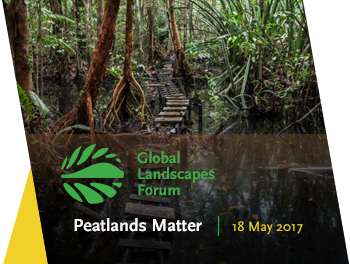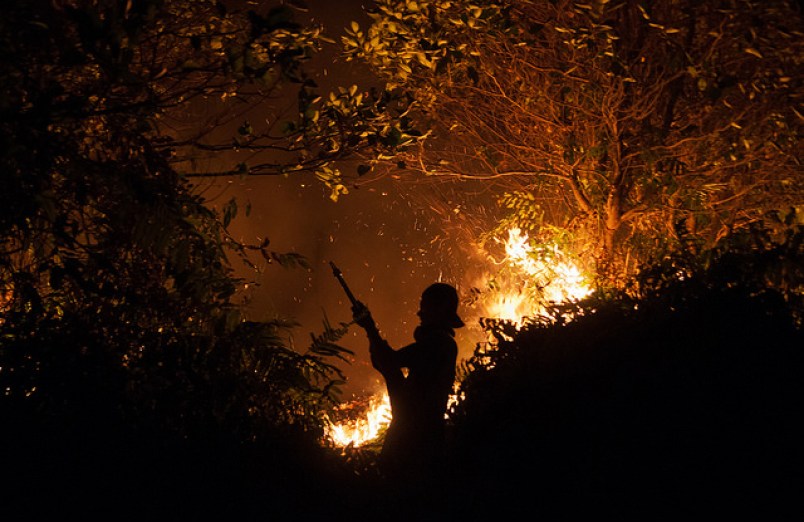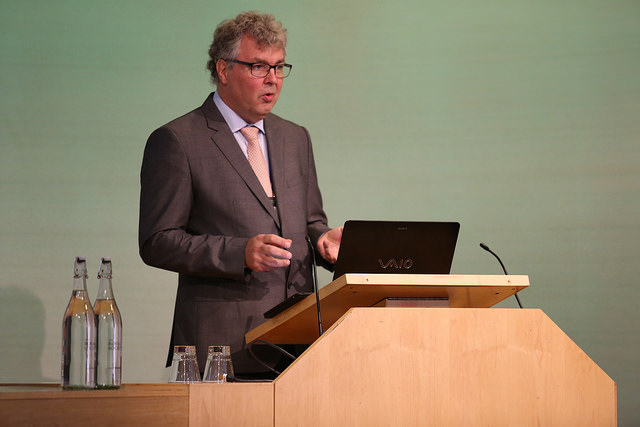How can sustainable landscape management attract more finance towards sustainable rehabilitation, peatland restoration and conservation?
How can we best mobilize the scale of finance needed to meet restoration targets? What is needed and from whom? What are some of the considerations for financing for large scale private investments, donor contributions and public sector investments?
These were just some of the thought-provoking questions addressed during the discussion forum, Financing sustainable peatland management: Mobilizing, utilizing and leveraging public and private investments to reach Indonesia’s peatland restoration targets, held at the Global Landscapes Forum: Peatlands Matter event in Jakarta on May 18. The Forum brought together 425 diverse stakeholders from the government, private sector, science and civil society to accelerate positive action in the management of global peatlands.
Ann Jeannette Glauber, Lead Environmental Specialist for Indonesia at the World Bank, moderated the dynamic session that featured speakers from the International Finance Corporation, Tropical Forest Alliance 2020 and Indonesia’s Ministry of Finance. Glauber sat down with Forests News’ Editor-in-Chief Leona Liu after her session to discuss the costs of peatland fires and degradation to the Indonesian economy, as well as to offer viable ways to upscale current investments to incentivize sustainable peat restoration.
*Read the full transcript of the TV interview below
Today’s thematic topic focuses on peatlands. Why do we care?
Such a great question! We were just upstairs talking about why peat is sexy. In fact, it really is sexy. Peatlands are incredibly important. I’m sure you’ve spoken with many scientists about its importance to climate regulation, its importance to biodiversity, but here in Indonesia, they are also incredibly important to livelihoods, to jobs. It’s where most of the oil palm is grown and a lot of forestry takes place, so these are very important landscapes from a productivity and economic perspective.
They’re also a source of most of the haze that blankets Southeast Asia every several years when forests and land fires in Indonesia takes place. So management of peatlands is incredibly important for a variety of reasons in Indonesia.
When it comes to peatlands management, people often think it’s a huge investment. However, the cost of forgoing it is often higher. The World Bank actually published a very interesting report about how much money the Indonesian government lost due to the fire and haze crisis in 2015. Can you talk about that?
In fact, it’s mind-boggling. In 2015, just between August and October, when Indonesia’s El Nino-driven forest and land fires were at their worst, Indonesia’s emissions on a daily basis from fire were more than the emissions from the entire European Union (EU) economy, so it’s hugely important from a global climate dimension.
But it’s also very important to Indonesia and Indonesia’s economy. We estimated that the losses due to health impacts; education (kids who were stuck in their homes and weren’t able to go to school); businesses who couldn’t function because their trucks or their airplanes couldn’t take off because of the haze; and actual losses because land burned up- in fact, this cost the Indonesian government about 16.1 billion U.S. dollars, that’s 2 percent of GDP in one of the G20 nations, a huge amount of money. It’s about two times the cost of the reconstruction from the Aceh tsunami to give you a sense of scale. And that’s due to an issue that is 100 percent manmade.
Do you feel that the World Bank report was impactful in serving as a wakeup call about how serious it is to invest in prevention measures?
Those numbers actually changed the way that the Indonesians looked at the issue of fire and haze going into the December 2015 COP in Paris. [Indonesian] President Jokowi went there recognizing that taking action on fire and haze and land management in Indonesia mattered, not just for Indonesia, but for the rest of the world.
And he came in and made some very important commitments to address some of the major drivers of land degradation and peat degradation in Indonesia. That included looking at land tenure and land mapping and administration; fire management and prevention; and also investing quite significantly in moving towards restoring over 2 million hectares of peatlands and taking bold action to try to prevent the future conversion of peatlands, including through putting a temporary moratorium on oil palm licenses. So really quite impressive action on the part of the government of Indonesia.
What do you think is stopping financial investment today in meeting restoration targets? What are some of the best way to scale this up and get countries to invest?
That’s the million-dollar question. One of the things we just heard upstairs in the panel on financing peat restoration in Indonesia is that there is actually a lot of money on the table. The [Indonesian] government is spending billions of dollars in large-scale land management in Indonesia. The question is how can you redirect that to be more efficient and have better outcomes for the environment, the people, and the economy. So that’s really the challenge.
And what we heard upstairs was that there is really a need to come together and put clear rules of the game in place, so that companies can invest safely with minimal risk… making sure that there’s strong accountability and transparency measures. Making sure that everyone is accountable for what they do will go a long way in terms of raising financing from the private sector, also from government who needs to be the major funder of these activities, and donors who will come in for a slice of that.
The philosophy behind the Global Landscapes Forum is to get different stakeholders to sit together at the same table rather than sit in silos. Did you see that coming together today? Were you able to reach across the table yourself and meet people from different words working on similar issues?
It was really very exciting to see that today. This is a new area. Clearly, we are going to need all sides to come together from civil society, from academia, from private sector, from government, from donors. Seeing that is really quite exciting. We need these opportunities to come together to learn from each other, to find new ways to work. So that was very exciting for me to see.
From the World Bank perceptive, when we look to what it takes to get to real sustainable land management, we see the need to also bring these actors together, working across the various sectors that have implications for land use- so agriculture, environment, water and land management, private sector. All these different parts need to come together to showcase how the tradeoffs between the different sectors can really be matched to work towards a new vision of land management.
*This is part of a series of video interviews from the 2017 Global Landscapes Forum: Peatlands Matter thematic event in Jakarta, Indonesia
We want you to share Forests News content, which is licensed under Creative Commons Attribution-NonCommercial-ShareAlike 4.0 International (CC BY-NC-SA 4.0). This means you are free to redistribute our material for non-commercial purposes. All we ask is that you give Forests News appropriate credit and link to the original Forests News content, indicate if changes were made, and distribute your contributions under the same Creative Commons license. You must notify Forests News if you repost, reprint or reuse our materials by contacting forestsnews@cifor-icraf.org.


